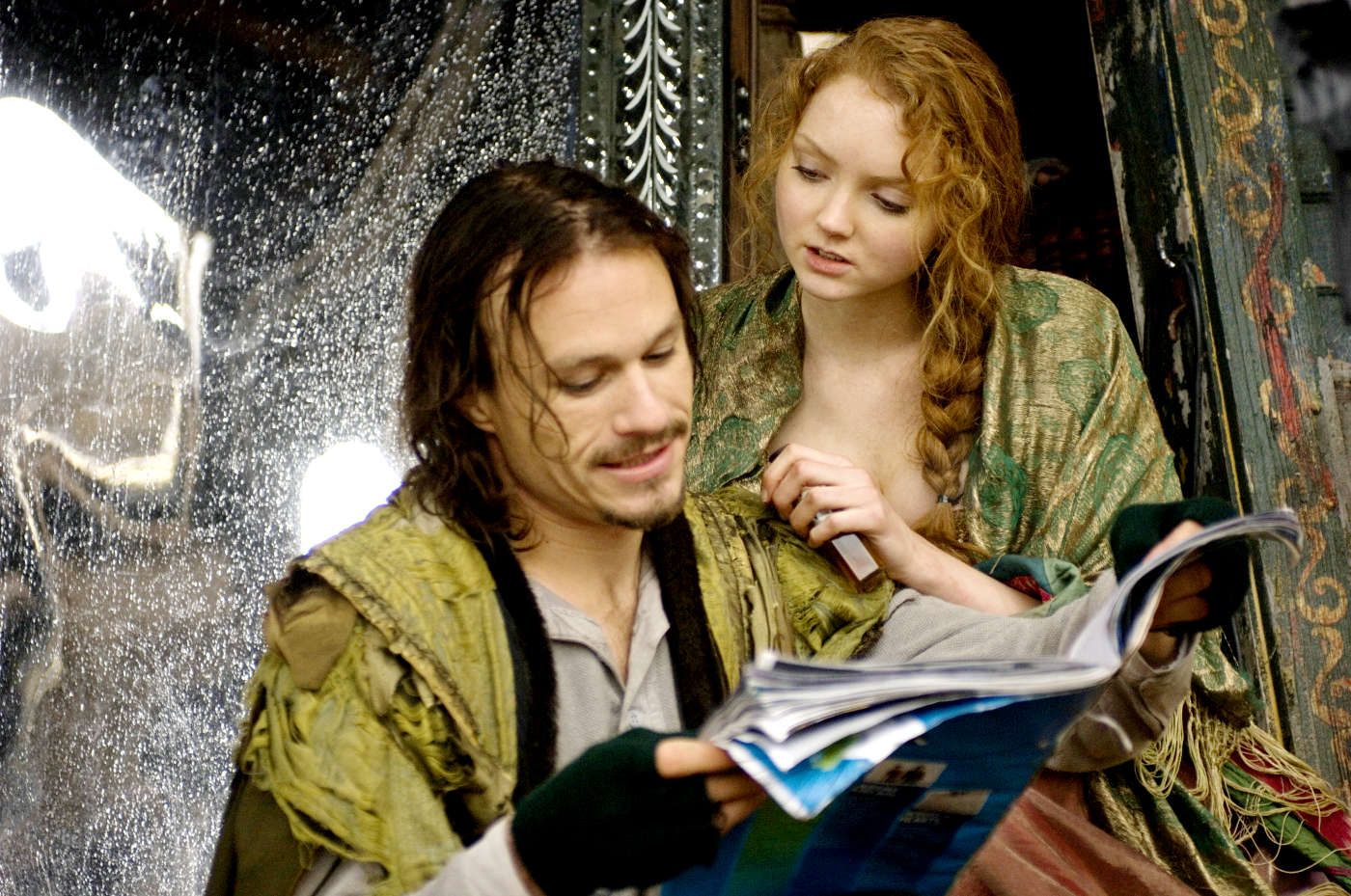By Chlotrudis Independent Film Society
Rating: 2 cats
Director: Terry Gilliam
Starring: Christopher Plummer | Colin Farrell | Heath Ledger | Johnny Depp | Jude Law | Lily Cole | Tom Waits

Country: canada, france, united_kingdom
Year: 2009
Running time: 122
IMDB: http://www.imdb.com/title/tt1054606/
Jason says: “Ordinarily, when good people make a bad movie, there’s a tendency to hunt for where things went wrong. THE IMAGINARIUM OF DOCTOR PARNASSUS offers an obvious and logical culprit: The sudden death of its star, Heath Ledger, midway through filming. But for all that the contortions that writer/director Terry Gilliam had to go through to work around that tragic event, it seems likely that Parnassus would have been a mess whether Ledger were able to complete the film or not.
“Dr. Parnassus (Christopher Plummer) has a traveling show with one attraction – a magic mirror behind which those who enter find dreamscapes partly created by Parnassus, although Mr. Nick (Tom Waits) lurks to tempt them off the safe path so that he can steal their souls. He runs it with old friend Percy (Verne Troyer), daughter Valentina (Lily Cole), and runaway Anton (Andrew Garfield). They’re poor, but mostly a happy family, at least on the surface. Underneath, Anton nurses a crush on Lily, Lily fantasizes about a more conventional life, and Parnassus and Percy fret about the debt to Mr. Nick that will come due on Lily’s fast-approaching sixteenth birthday. Does the amnesiac they rescue from under a bridge (Heath Ledger) bring solutions or more problems?
‘Audiences familiar with Terry Gilliam’s work will see his fingerprints on the film almost from the first frame, for good and ill. Parnassus’s show is the sort of grimy, ill-maintained environment that he always seems to start from. The fantasy sequences begin as two-dimensional, clearly artificial environments before coming to fully-rendered life. There’s an underlying mythology that speaks to the power of imagination and storytelling, although the emphasis is on the things that Gilliam clearly values most – sweeping imagery and broad ideas, as opposed to a great deal of plot or detail.
‘Gilliam is known – infamous, even – for presiding over troubled productions, with the travails sometimes self-inflicted (I think he badly needs a producing partner who can reign him in, say ‘you’ll lose the audience with this’). That’s not the case this time, but while the shooting schedule offered up an intriguing solution – the bulk of the scenes left to film took place within the magic mirror, so they had Ledger’s Tony played by different actors on ‘the other side,’ it winds up being an awkward compromise. The three actors (Johnny Depp, Jude Law, and Colin Farrell) are made up to look as much like Ledger as possible, so they often only seem sort of different, even though that is now a plot point. It’s just noticeable enough to be distracting but not exploited enough to be significant. There’s a sequence at the beginning that seems grafted on to demonstrate that the mirror can reveal this two-faced nature in people, but it winds up dragging out the movies first act and making it somewhat repetitive.
“Of course, it may have been there from the start, with the face-changing added later. For all that having to make changes halfway through is the most obvious culprit in the film faltering, it’s far from the only one. The final trip behind the mirror is a mess not because it features Colin Farrell rather than Heath Ledger – I actually enjoyed Farrell’s performance more than Ledger’s, though it’s odd that the build-up and the climax of that character’s arc are delivered in such different styles – but because it seems like Gilliam and co-writer Charles McKeown have no idea what they want it to be about, and it shines a light on all of the script’s other faults. It can’t decide whether or not Valentina’s or Tony’s soul is the one in the balance, and shows just what sort of short shrift Valentina has gotten over the course of the film, despite it being her story as much as anybody’s. Characters are tossed aside in ways that leave the audience unsure how to feel, because it’s not clear how permanent what happens on the other side is. And whether a character is viewed as a screw-up, opportunist, or monster rests on whether or not the audience catches some easily-overlooked comments to which it is not given time to react. The movie is problematic but forgiveably so beforehand, but devolves into a real mess by the end.
“That’s doubly frustrating, because there is actually plenty to praise. Gilliam has some heady, cool ideas with visuals to match – I love the monks who believe that they must recite the story of the world in order for the universe to keep going, for instance. Some of the Imaginarium imagery is the most joyful, delighted-with-creating things he has put on-screen since Baron Munchausen. There are some great surprises in the cast: Lily Cole, for instance, and the pairing of Christopher Plummer and Verne Troyer creates some great odd-couple banter. Colin Farrell offers a welcome reminder of how good he can be given the chance to play a good part, rather than fake an American accent in a bland action movie (Jude Law also improves upon Ledger’s frequently dull, mumbly performance).
“It’s a shame that this winds up being Ledger’s last movie; maybe we can just agree that partials count and say he finished on THE DARK KNIGHT? It’s also a bit unfortunate that it disguises the other problems with the movie, as that lays the blame on people like Ledger, Farrell, and Law who really don’t deserve it. 2 cats
“Seen 9 January 2010 in AMC Harvard Square #1 (first-run)”
